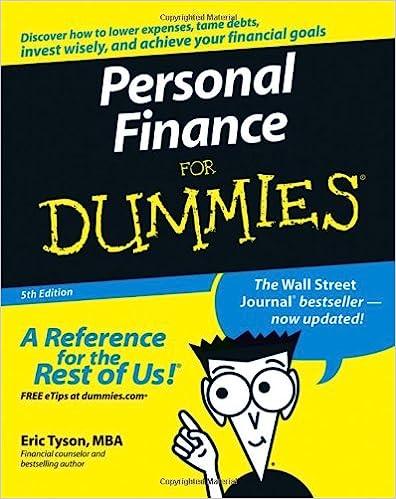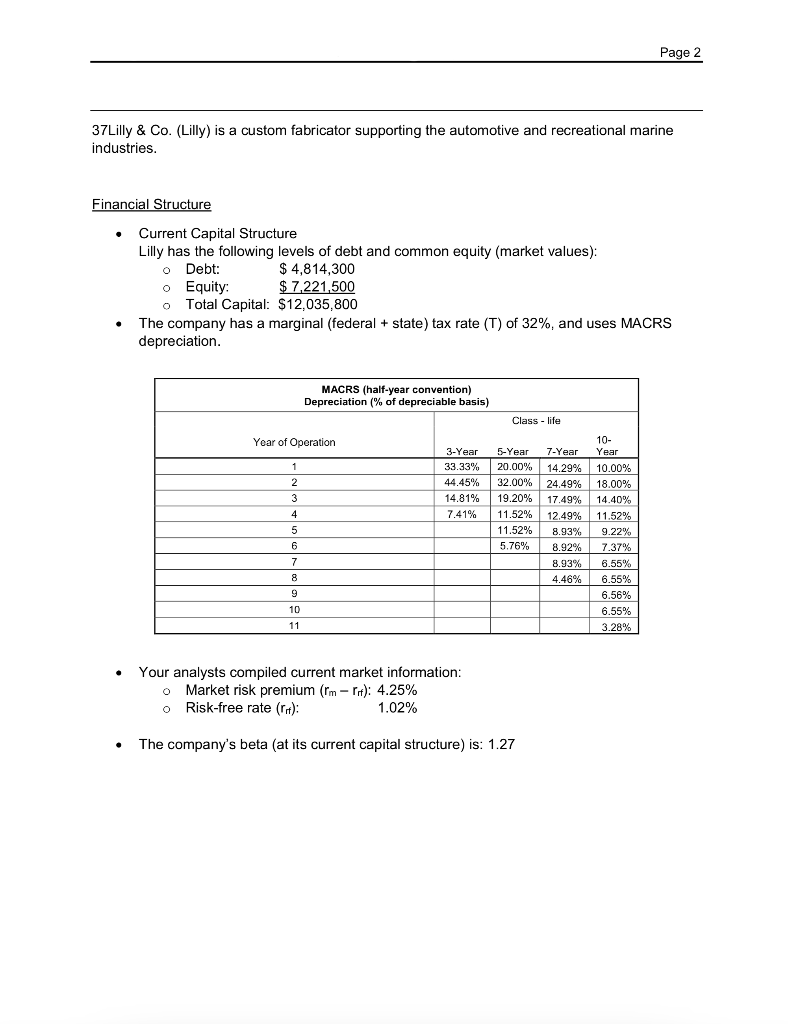
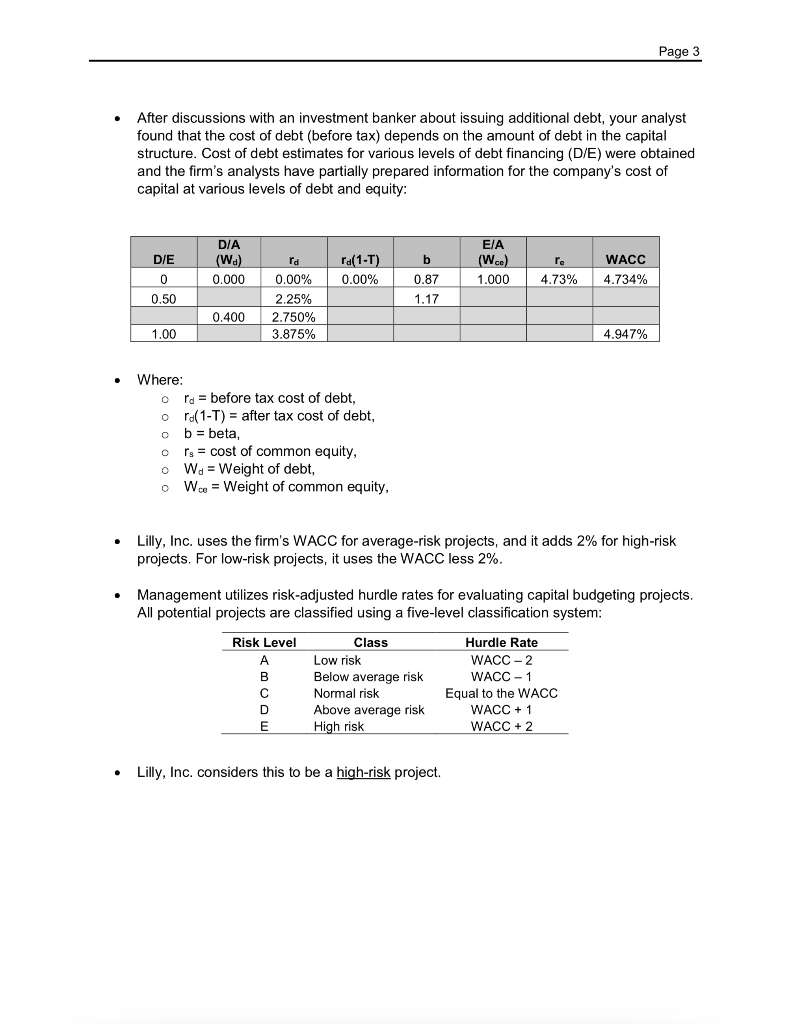
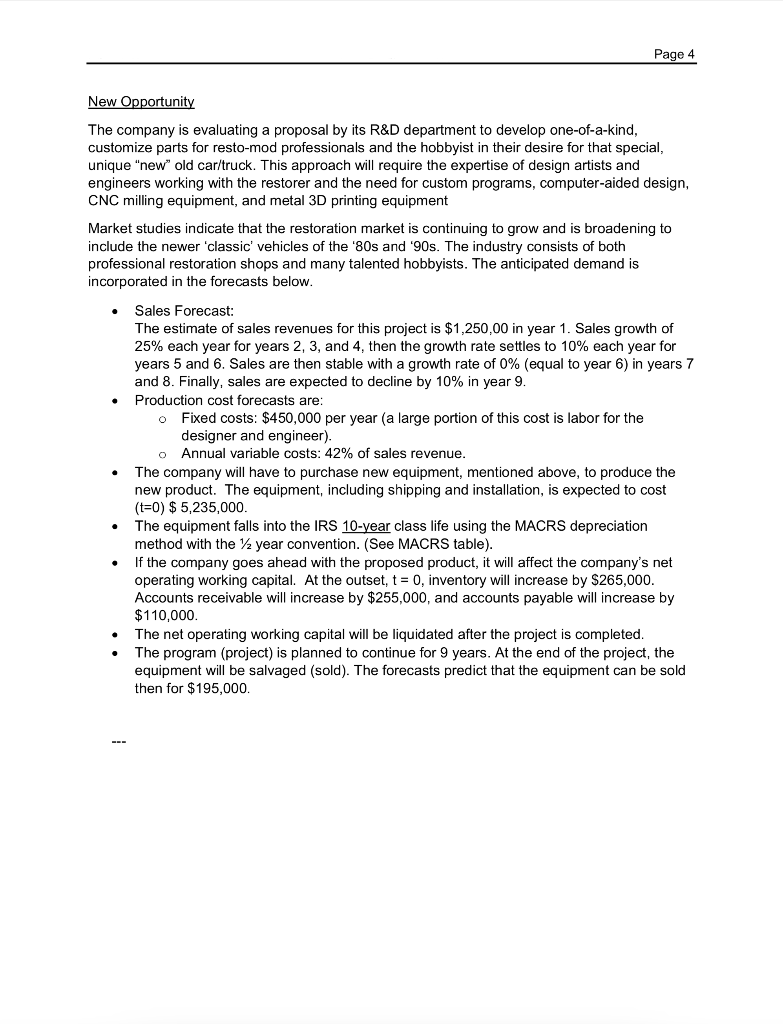
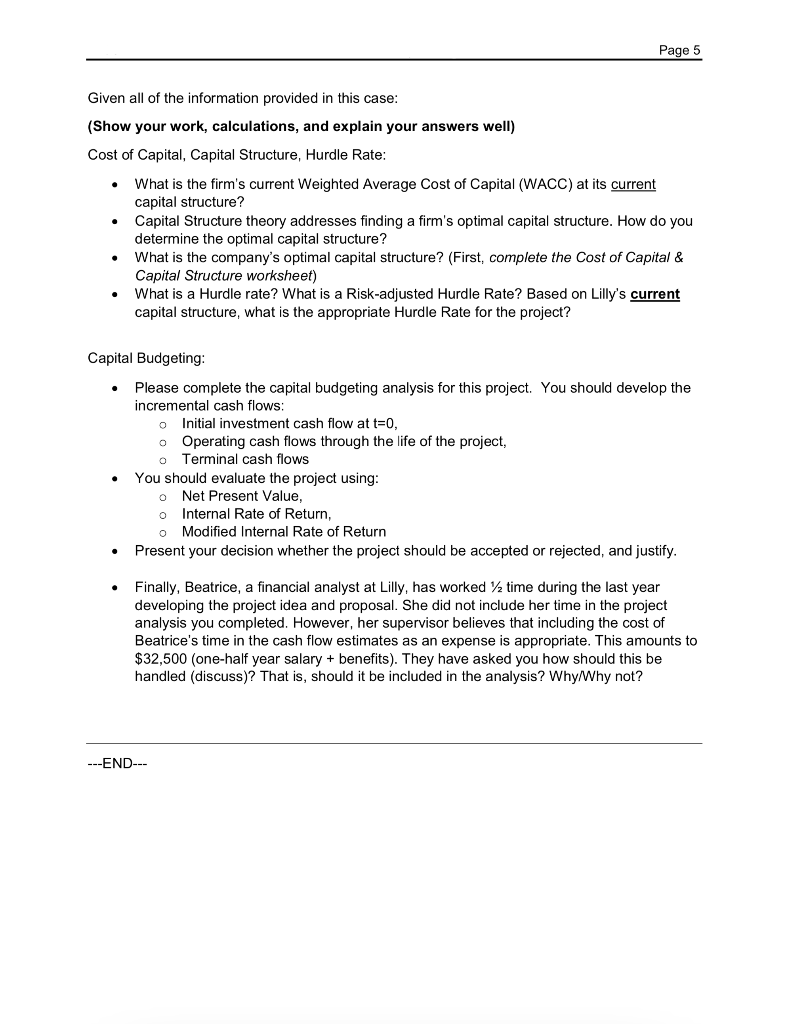
Page 2 37Lilly & Co. (Lilly) is a custom fabricator supporting the automotive and recreational marine industries. . Financial Structure Current Capital Structure Lilly has the following levels of debt and common equity (market values): o Debt: $ 4,814,300 o Equity: $ 7,221,500 o Total Capital: $12,035,800 The company has a marginal (federal + state) tax rate (T) of 32%, and uses MACRS depreciation. MACRS (half-year convention) Depreciation (% of depreciable basis) Year of Operation 1 2 3 4 5 3-Year 33.33% 44.45% 14.81% 7.41% Class - life 10- 5-Year 7-Year Year 20.00% 14.29% 10.00% 32.00% 24.49% % 18.00% 19.20% 17.49% 14.40% 14.40% 11.52% 12.49% 11.52% 11.52% 8.93% 9.22% 5.76% 8.92% 7.37% 10 8.93% 6.55% 0.00 4.46% 6.55% 6.56% 6.55% 3.28% 7 8 9 10 11 Your analysts compiled current market information: Market risk premium (rm -rf): 4.25% O Risk-free rate (rrt): 1.02% O . The company's beta (at its current capital structure) is: 1.27 Page 3 After discussions with an investment banker about issuing additional debt, your analyst found that the cost of debt (before tax) depends on the amount of debt in the capital structure. Cost of debt estimates for various levels of debt financing (D/E) were obtained and the firm's analysts have partially prepared information for the company's cost of capital at various levels of debt and equity: D/E DIA (Wa) 0.000 ra(1-T) 0.00% EIA (wce) 1.000 b 0.87 1.17 re 4.73% WACC 4.734% 0 0.50 ra 0.00% 2.25% 2.750% 3.875% 0.400 1.00 4.947% 0 Where: ra = before tax cost of debt, o ra(1-T) = after tax cost of debt, o b = beta, rs = cost of common equity, o W. = Weight of debt, Wc = Weight of common equity, O Lilly, Inc. uses the firm's WACC for average-risk projects, and it adds 2% for high-risk projects. For low-risk projects, it uses the WACC less 2%. Management utilizes risk-adjusted hurdle rates for evaluating capital budgeting projects. All potential projects are classified using a five-level classification system: Risk Level A B D E Class Low risk Below average risk Normal risk Above average risk High risk Hurdle Rate WACC - 2 WACC - 1 Equal to the WACC WACC + 1 WACC + 2 Lilly, Inc. considers this to be a high-risk project. Page 4 New Opportunity The company is evaluating a proposal by its R&D department to develop one-of-a-kind, customize parts for resto-mod professionals and the hobbyist in their desire for that special, unique "new" old car/truck. This approach will require the expertise of design artists and engineers working with the restorer and the need for custom programs, computer-aided design, CNC milling equipment, and metal 3D printing equipment Market studies indicate that the restoration market is continuing to grow and is broadening to include the newer 'classic' vehicles of the '80s and '90s. The industry consists of both professional restoration shops and many talented hobbyists. The anticipated demand is incorporated in the forecasts below. Sales Forecast: The estimate of sales revenues for this project is $1,250,00 in year 1. Sales growth of 25% each year for years 2, 3, and 4, then the growth rate settles to 10% each year for years 5 and 6. Sales are then stable with a growth rate of 0% (equal to year 6) in years 7 and 8. Finally, sales are expected to decline by 10% in year 9. Production cost forecasts are: Fixed costs: $450,000 per year (a large portion of this cost is labor for the designer and engineer). Annual variable costs: 42% of sales revenue. The company will have to purchase new equipment, mentioned above, to produce the new product. The equipment, including shipping and installation, is expected to cost (t=0) $ 5,235,000. The equipment falls into the IRS 10-year class life using the MACRS depreciation method with the 12 year convention. (See MACRS table). If the company goes ahead with the proposed product, it will affect the company's net operating working capital. At the outset, t = 0, inventory will increase by $265,000. Accounts receivable will increase by $255,000, and accounts payable will increase by $110,000 The net operating working capital will be liquidated after the project is completed. The program (project) is planned to continue for 9 years. At the end of the project, the equipment will be salvaged (sold). The forecasts predict that the equipment can be sold then for $195,000. Page 5 Given all of the information provided in this case: (Show your work, calculations, and explain your answers well) Cost of Capital, Capital Structure, Hurdle Rate: What is the firm's current Weighted Average Cost of Capital (WACC) at its current capital structure? Capital Structure theory addresses finding a firm's optimal capital structure. How do you determine the optimal capital structure? What is the company's optimal capital structure? (First, complete the cost of Capital & Capital Structure worksheet) What is a Hurdle rate? What is a Risk-adjusted Hurdle Rate? Based on Lilly's current capital structure, what is the appropriate Hurdle Rate for the project? . Capital Budgeting: Please complete the capital budgeting analysis for this project. You should develop the incremental cash flows: Initial investment cash flow at t=0, o Operating cash flows through the life of the project, o Terminal cash flows You should evaluate the project using: Net Present Value, Internal Rate of Return, o Modified Internal Rate of Return Present your decision whether the project should be accepted or rejected, and justify. . 0 . Finally, Beatrice, a financial analyst at Lilly, has worked 1 time during the last year developing the project idea and proposal. She did not include her time in the project analysis you completed. However, her supervisor believes that including the cost of Beatrice's time in the cash flow estimates as an expense is appropriate. This amounts to $32,500 (one-half year salary + benefits). They have asked you how should this be handled (discuss)? That is, should it be included in the analysis? Why/Why not? ---END--- Page 2 37Lilly & Co. (Lilly) is a custom fabricator supporting the automotive and recreational marine industries. . Financial Structure Current Capital Structure Lilly has the following levels of debt and common equity (market values): o Debt: $ 4,814,300 o Equity: $ 7,221,500 o Total Capital: $12,035,800 The company has a marginal (federal + state) tax rate (T) of 32%, and uses MACRS depreciation. MACRS (half-year convention) Depreciation (% of depreciable basis) Year of Operation 1 2 3 4 5 3-Year 33.33% 44.45% 14.81% 7.41% Class - life 10- 5-Year 7-Year Year 20.00% 14.29% 10.00% 32.00% 24.49% % 18.00% 19.20% 17.49% 14.40% 14.40% 11.52% 12.49% 11.52% 11.52% 8.93% 9.22% 5.76% 8.92% 7.37% 10 8.93% 6.55% 0.00 4.46% 6.55% 6.56% 6.55% 3.28% 7 8 9 10 11 Your analysts compiled current market information: Market risk premium (rm -rf): 4.25% O Risk-free rate (rrt): 1.02% O . The company's beta (at its current capital structure) is: 1.27 Page 3 After discussions with an investment banker about issuing additional debt, your analyst found that the cost of debt (before tax) depends on the amount of debt in the capital structure. Cost of debt estimates for various levels of debt financing (D/E) were obtained and the firm's analysts have partially prepared information for the company's cost of capital at various levels of debt and equity: D/E DIA (Wa) 0.000 ra(1-T) 0.00% EIA (wce) 1.000 b 0.87 1.17 re 4.73% WACC 4.734% 0 0.50 ra 0.00% 2.25% 2.750% 3.875% 0.400 1.00 4.947% 0 Where: ra = before tax cost of debt, o ra(1-T) = after tax cost of debt, o b = beta, rs = cost of common equity, o W. = Weight of debt, Wc = Weight of common equity, O Lilly, Inc. uses the firm's WACC for average-risk projects, and it adds 2% for high-risk projects. For low-risk projects, it uses the WACC less 2%. Management utilizes risk-adjusted hurdle rates for evaluating capital budgeting projects. All potential projects are classified using a five-level classification system: Risk Level A B D E Class Low risk Below average risk Normal risk Above average risk High risk Hurdle Rate WACC - 2 WACC - 1 Equal to the WACC WACC + 1 WACC + 2 Lilly, Inc. considers this to be a high-risk project. Page 4 New Opportunity The company is evaluating a proposal by its R&D department to develop one-of-a-kind, customize parts for resto-mod professionals and the hobbyist in their desire for that special, unique "new" old car/truck. This approach will require the expertise of design artists and engineers working with the restorer and the need for custom programs, computer-aided design, CNC milling equipment, and metal 3D printing equipment Market studies indicate that the restoration market is continuing to grow and is broadening to include the newer 'classic' vehicles of the '80s and '90s. The industry consists of both professional restoration shops and many talented hobbyists. The anticipated demand is incorporated in the forecasts below. Sales Forecast: The estimate of sales revenues for this project is $1,250,00 in year 1. Sales growth of 25% each year for years 2, 3, and 4, then the growth rate settles to 10% each year for years 5 and 6. Sales are then stable with a growth rate of 0% (equal to year 6) in years 7 and 8. Finally, sales are expected to decline by 10% in year 9. Production cost forecasts are: Fixed costs: $450,000 per year (a large portion of this cost is labor for the designer and engineer). Annual variable costs: 42% of sales revenue. The company will have to purchase new equipment, mentioned above, to produce the new product. The equipment, including shipping and installation, is expected to cost (t=0) $ 5,235,000. The equipment falls into the IRS 10-year class life using the MACRS depreciation method with the 12 year convention. (See MACRS table). If the company goes ahead with the proposed product, it will affect the company's net operating working capital. At the outset, t = 0, inventory will increase by $265,000. Accounts receivable will increase by $255,000, and accounts payable will increase by $110,000 The net operating working capital will be liquidated after the project is completed. The program (project) is planned to continue for 9 years. At the end of the project, the equipment will be salvaged (sold). The forecasts predict that the equipment can be sold then for $195,000. Page 5 Given all of the information provided in this case: (Show your work, calculations, and explain your answers well) Cost of Capital, Capital Structure, Hurdle Rate: What is the firm's current Weighted Average Cost of Capital (WACC) at its current capital structure? Capital Structure theory addresses finding a firm's optimal capital structure. How do you determine the optimal capital structure? What is the company's optimal capital structure? (First, complete the cost of Capital & Capital Structure worksheet) What is a Hurdle rate? What is a Risk-adjusted Hurdle Rate? Based on Lilly's current capital structure, what is the appropriate Hurdle Rate for the project? . Capital Budgeting: Please complete the capital budgeting analysis for this project. You should develop the incremental cash flows: Initial investment cash flow at t=0, o Operating cash flows through the life of the project, o Terminal cash flows You should evaluate the project using: Net Present Value, Internal Rate of Return, o Modified Internal Rate of Return Present your decision whether the project should be accepted or rejected, and justify. . 0 . Finally, Beatrice, a financial analyst at Lilly, has worked 1 time during the last year developing the project idea and proposal. She did not include her time in the project analysis you completed. However, her supervisor believes that including the cost of Beatrice's time in the cash flow estimates as an expense is appropriate. This amounts to $32,500 (one-half year salary + benefits). They have asked you how should this be handled (discuss)? That is, should it be included in the analysis? Why/Why not? ---END










